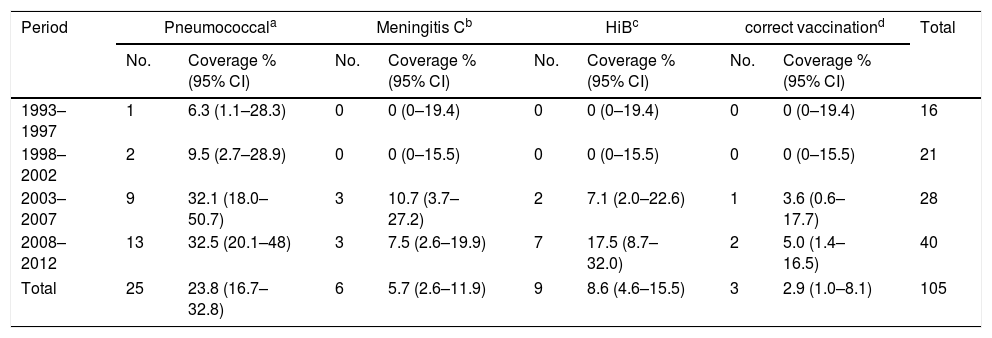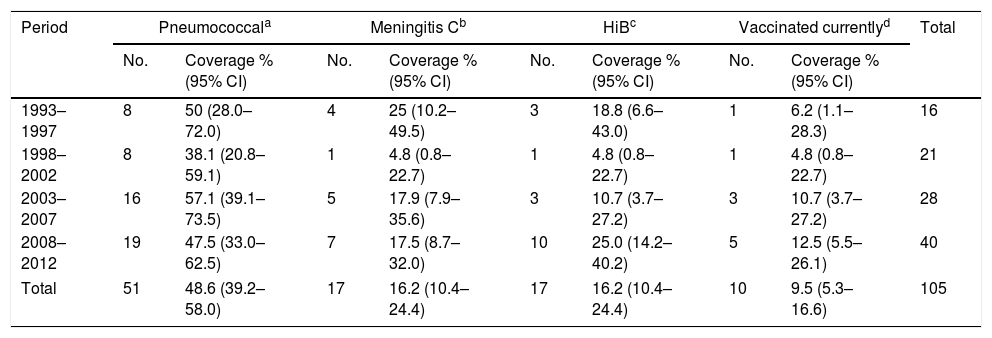Splenectomy patients have a high risk of suffering severe infections, many of them preventable by vaccination. The aim of the study was to analyse the clinical epidemiological characteristics and vaccine coverage of these patients in Health Area III of the Region of Murcia.
MethodA cross-sectional study was conducted on a population of patients that were splenectomised during the period 1993–2012, according to the Register of the Basic Minimum Data Set. Patients were classified on the basis of splenectomy (neoplasm, haematological diseases, trauma, and others), vaccination, and vital status, using official records of health data. Statistical analysis was performed using SPSS 21.0 statistics programme.
ResultsThe sample consisted of 196 patients, of which 68.4% (n=134) were male. The mean age at which they underwent splenectomy was 50.1 years (SD: 22.2). The most common reason for removal of the spleen was neoplasia in 39.1% (n=59). Splenectomy due to trauma reasons was associated with lower patient age (p<.001) and male gender (p=.03). Vaccination coverage for Streptococcus pneumoniae was 23.8%, 5.7% for Neisseria meningitidis C, and 8.6% for Haemophilus influenzae B. Only 2.9% of patients were correctly vaccinated for all three.
ConclusionsVaccination coverage was insufficient for this fragile patient profile. It should be taken into account in the early detection and counselling in this group so susceptible to disease, with nurses being a decisive part in the process.
Los pacientes asplénicos tienen un elevado riesgo de infecciones graves, muchas prevenibles mediante vacunación. El objetivo del estudio fue analizar las características clinicoepidemiológicas y cobertura vacunal de estos pacientes en el Área III de Salud de la Región de Murcia.
MétodoEstudio transversal cuya población de estudio fueron pacientes esplenectomizados durante 1993-2012, según el Registro del Conjunto Mínimo Básico de Datos. Los pacientes se clasificaron por motivo de esplenectomía (neoplasias, enfermedades hematológicas, traumatismos y otras), estado vacunal y estado vital. Para ello se utilizaron los registros oficiales de datos sanitarios. El análisis estadístico se realizó con el programa estadístico SPSS 21.0.
ResultadosLa muestra se constituyó por 196 pacientes. El 68,4% (n=134) eran hombres. La edad media a la que se les practicó la esplenectomía fue a los 50,1 años (DE: 22,2). El motivo más frecuente de la extirpación del bazo fue la neoplasia en un 39,1% (n=59). La esplenectomía por motivos traumatológicos se asoció a una menor edad del paciente (p<0,001) y género masculino (p=0,03). La cobertura de vacunación para Streptococcus pneumoniae fue del 23,8%, 5,7% para Neisseria meningitidis serogrupo C, y 8,6% para Haemophilus influenzae B. Solo el 2,9% de los enfermos se encontraban correctamente vacunados para las tres.
ConclusionesLas coberturas vacunales fueron insuficientes para este perfil de paciente frágil. Se debe incidir en la captación precoz y asesoramiento en este colectivo tan susceptible a la enfermedad, siendo los profesionales de enfermería piezas determinantes en el proceso.










